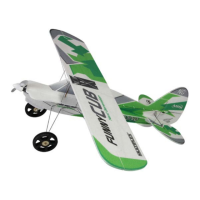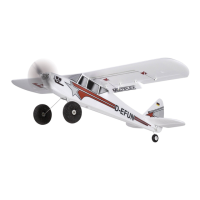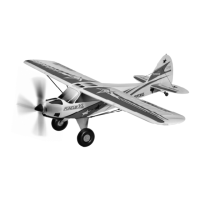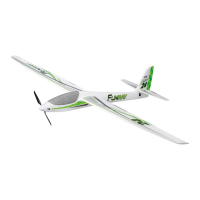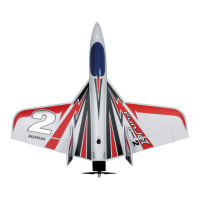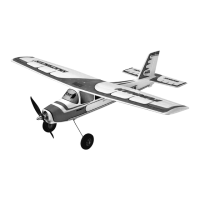19
Assembly instructions
10. Assembling the wings (do not yet install the servos)
Place all required parts close to hand on your construction table
Fig. 21
.
Fitting parts without adhesive rst helps to avoid subsequent errors.
Now position the landing ap in the recess of the wing. There is a small
trick to ensure an equal gap on the left and the right. Take two strips of
thin cardboard or double-folded paper and place them in the gap. The
same applies to the distance to the wing. Two strips of folded paper are
sufcient here to maintain a sufcient distance. This ensures correct
assembly of the landing aps.
After everything has been aligned properly, the hinges and rudder horns
can be glued into place. The procedure is the same as for the tail units.
Be especially careful not to glue a hinge or rudder horn on the wrong side
during this construction step. Once the wing strut bracket
has been
glued into place, assemble the second wing in the same manner.
11. Preparing the wing servos
You need a pair of aileron servos and a pair of landing ap servos. Assembly
of the servo arm was described under Point3; “Preparing the fuselage
servos”. The only difference is with the landing ap servos, as a longer
arm is needed in this case
Fig. 22
. If you use the recommended HS -55
+ servos, the mounting points can also be used here. After the servos
have been glued into place, the extension cable can be plugged in and
the servo cables can be stored in the channels provided for this purpose.
Use a strip of adhesive tape to x the cables into place. To assemble
and disassemble the model comfortably, use our cable set FunCub NG
#1-01478. It contains all the necessary extensions and plug fuses.
Assemble the aileron pushrods
as shown in
Fig. 22
. The servo is
controlled by a neutral pulse. The landing ap servos, on the other hand,
must be in the end position with the servo arm pointing towards the ap.
When adjusted in this manner, a downward rudder deection of almost
90° is guaranteed.
Caution: The servo must under no circumstances run to the stop at
0° ap position. It could burn out otherwise. This also applies to all
the other servos.
Now x the wingspar connectors
to one wing half with a small
amount of Zacki2 ELAPOR
®
, otherwise the wings can no longer be
separated
Fig. 23
.
12. Installing the optional aero-tow release
The aero-tow release
can be retrotted at any time. Glue it into the
recess on the right wing provided for this purpose
Fig. 24
. The servo
pocket is prepared for a HS-55+. Glue the servo into place with Zacki2
ELAPOR
®
. The pushrod must be adapted to the servo arm used. Use
small at nose pliers to bend the pushrod to the desired shape. It is best
if the pushrod is hooked into the servo arm as far inside as possible. Now
move the aero-tow release to the “closed” position and cut off the excess
wire ush at the top. Use sandpaper or a le to deburr the wire at the
cutting edge.
13. Assembling the motor
Fig. 25
shows the schematic installation of the motor. If you use our
power kit #1-01423, everything is prepared to ensure correct tting. The
power kit contains detailed instructions, the special spacer ring and all
the necessary accessories. It is tailored to the FunCub NG and delivers
enough power to tow an EasyGlider, Solius, Heron or Funray several times
to a sufcient starting height.
14. Completing the canopy
First glue the hand-hold plate 13 ush to the underside of the canopy
Fig. 26
. The recesses for the canopy closure plugs must correspond to
the pockets in the foam as precisely as possible. Now apply some Zacki2
ELAPOR
®
to the pockets and press in the closure plugs until the top tooth
of the plug is ush with the hand-hold plate. Allow the adhesive to set and
then place the canopy on the fuselage for testing. The closures should
engage properly.
15. Preparing the wing struts
Feed the threaded rod
into the CFRP tube
.
Fig. 27
shows
assembly of the struts in close-up. On one side, a nut
is screwed
on roughly 10 mm. Apply some Zacki to the short, free threaded piece
and screw on a fork head
until the thread is ush with the inside of
the fork head. Now lock the nut against the fork head. Then secure the
threaded rod with some Zacki in the CFRP tube. On the other side, a nut
is also screwed on and secured with a drop of Zacki. Do not tighten
the nut too tightly, otherwise the CFRP tube may burst. If the length is
set correctly, the second fork head is locked with another nut
. The
V-shape of the wing should never be altered when adjusting the strut
length
Fig. 28
. To do so, assemble the model and attach the struts to
the wing. Now adjust the lower fork heads so that they can be hooked in
and out without tension. Use the supplied multi-tool
to open the fork
heads
Fig. 29
.
EN
